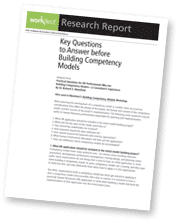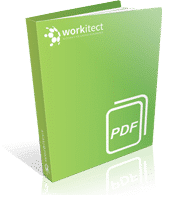Create Your Own Technical Competencies Dictionary Tailored to Your Organization
Include in Workitect’s Competency Dictionary
In Workitect’s model-building methodology, technical competencies are determined through interviews, expert panels, and other methods as described in “Add Technical Competencies to Your Competency Dictionary”, and as taught in our Building Competency Models and Creating Technical Competencies certification workshops. The purchase of a separate technical competency dictionary is not required.
When it is determined that superior performers in a position require a high level of technical expertise in a specific field, the technical competency (or competencies) can be included in a competency model as described in “How to Include Technical Competencies in Job Competency Models”.
Improve Organizational Performance with Technical Competencies
Technical Competencies ensure that departments develop the skills needed to implement the organization’s strategy and plans. Some of the reasons for identifying your technical competencies are:
- To develop a training and professional development curriculum to efficiently develop a technically skilled staff
- To be able to recognize and reward professional development among technically skilled individual contributors
- To enable HR staff to develop applications in professional development, developing career paths, and succession planning
Ready to add technical competencies customized to your organization?
Request more information or talk with a Workitect consultant about how our services, tools, and training can help you identify, describe, and apply technical competencies integrated with non-technical competencies.

What Are Technical Competencies?
Technical competencies describe the skills a person “must be able to do” to effectively perform in a specific job, role or function. Technical competencies describe distinct “units of work” performed by an individual. Technical competencies require the application of skills, knowledge and abilities. Technical competencies can be identified for specific jobs within one organization or across branches of an organization. Technical competencies are also developed at the industry or professional level to set performance standards for national certification and training programs.
Six Steps to Including Technical Competencies

Include Technical Competencies in Your Competency Library or Dictionary
Many organizations want to include technical competencies, skills, knowledge, in competency models and human resource applications. Off-the-shelf competency libraries and dictionaries for very specific technical specialties are available. Most are comprehensive, complex, and expensive.
In addition, the competencies are so job-specific that there may be no competency dictionaries or libraries that accurately describes all of the technical competencies used in an industry or organization. An alternative to using an off-the-shelf dictionary is to develop a custom dictionary, identifying the technical competencies using proven data collection and analysis techniques. Read More >
LEARN MORE ABOUT TECHNICAL COMPETENCIES
• Guided Launch of a Competency Modeling Project that Includes Technical Competencies
• Understanding General and Technical Competencies
Standard Levels for Technical Competencies
| Level | Definition |
|---|---|
| Basic Proficiency |
|
| Intermediate Proficiency |
|
| Full Proficiency |
|
| Expert |
|

Competency-Based HR Applications
Competency-based HR applications have been created for performance management, assessment and selection, succession planning/management, training and development, and workforce management (re-engineering, upskilling, downsizing, and mergers).
Practical Questions To Answer before Building Competency Models
When planning the development of a competency framework, competency model or models, there are practical considerations that affect the design of the project, the format and content of the competency model, and the success of the project’s implementation. The following seven questions may be useful to professionals responsible for planning and implementing:
- What HR application should be included in the initial competency model building project?
- What will the key users of the job competency model need from it?
- How should key stakeholders be involved?
- How extensive should the data collection be?
- How should research be balanced with intuitive approaches?
- What format of behavioral descriptors will best suit the HR application?
- How can additional, future competency models be accommodated?

To speak with a consultant about your situation, needs, and our capability to help:
Call 800-870-9490
Complete this contact form
Send an email to ec@workitect.com
What Our Customers Say
“I’ve seen many overly complicated systems. This is a more simplified competency dictionary.”




